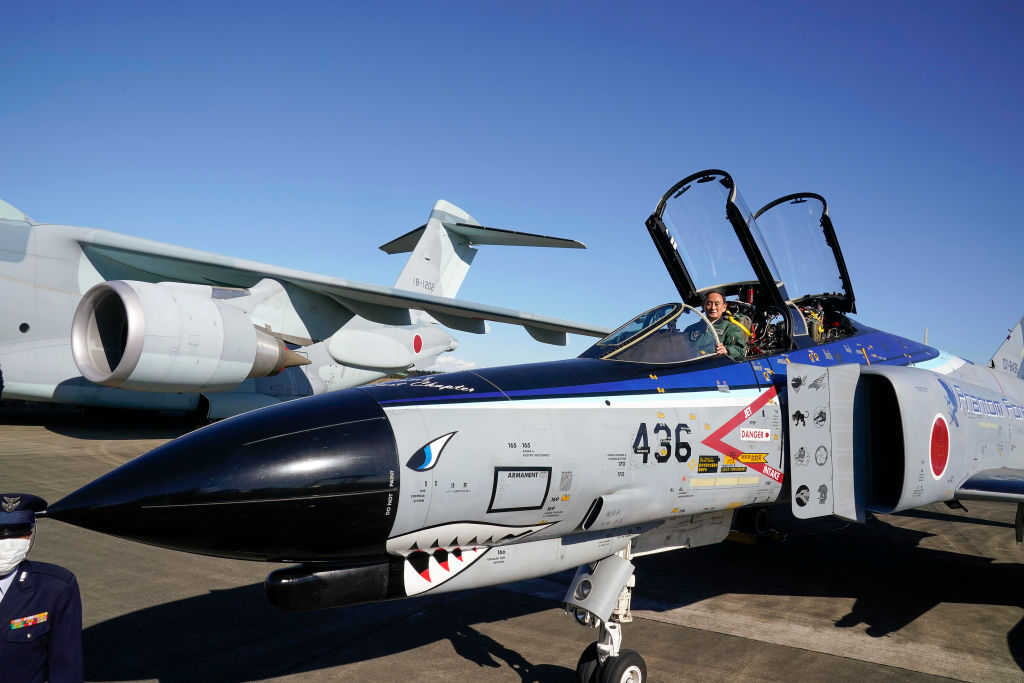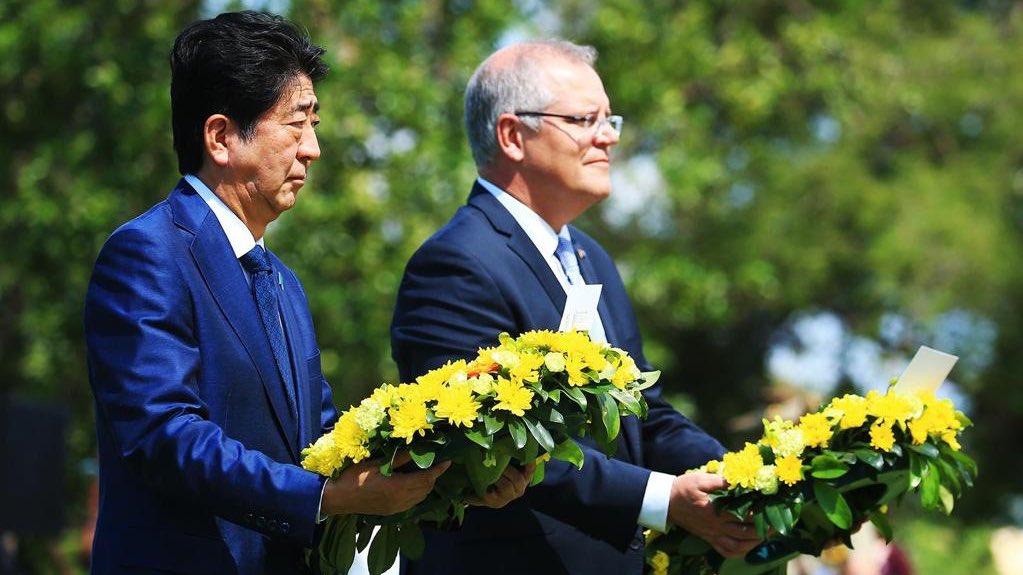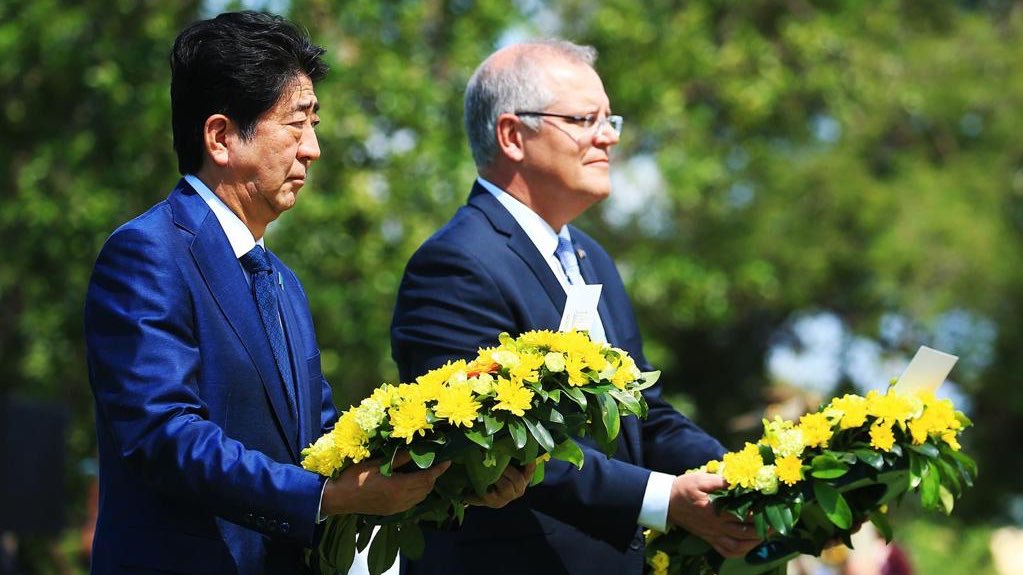After Abe: Where to for Australia’s quasi-alliance with Japan?
6 Oct 2020|
Graeme Dobell
SHARE
Print This Post
The departure of Abe Shinzo as Japan’s leader opens a new era for Canberra’s quasi-alliance with Tokyo.
Australia is going to find out how much its
small ‘a’ alliance is based on Abe and how much on more permanent shifts in Japan’s policy personality.
Was Abe an outlier or has he recast the mould for future leaders and Tokyo’s role in Asia? Japan’s
longest-serving prime minister was
transformative. Now we’ll see how deep the transformation goes.
Abe pushed for a
stronger, more autonomous Japan rather than a
comfortable Japan declining gently into middle-power ease.
Comfortable Japan would cuddle the peace of its pacifist strain, no longer wanting to serve as the US’s unsinkable aircraft carrier. The US–Japan alliance would fade as Tokyo decided the cost of resisting Beijing was too high. A Sinocentric future would be portrayed as Japan turning back to Asia.
One Abe-era change that fits either the strong or the comfortable narrative is the decision to
drop Western name order and return to Asian tradition, putting the surname first. Thus, this column refers to Abe Shinzo, rather than the previous Shinzo Abe ordering. Here was a prime minister who changed things.
A mark of Abe’s
impressive leadership was his ability to engage China but never bow to Beijing. As Ramesh Thakur
notes, Abe’s ‘foreign-policy and national-security accomplishments will be key parts of his enduring legacy’. Rod Lyon mused that Abe’s ‘
special relationship’ with Oz was atypical in the region—a level of strategic cooperation that no other Asian leader would reach for. Australia valued Abe’s declaration that Japan will have a
military and security role in Asia’s future.
Abe’s influence touched much that matters in Canberra:
- Japan has risen to become a defence partner for Australia on par with New Zealand and Britain. The quasi-alliance has deepened and Japan now sits on the second tier, with the traditional Anglo allies, below the peak where the US resides as the paramount ally.
- Japan and Australia were the first countries to place the Indo-Pacific atop their foreign policies in a new regional construct. A more conventional Japanese leader wouldn’t have overturned Tokyo’s old Asia–Pacific frame.
- The trilateral (Australia, Japan and the US) has been strengthened, making the linkage between the US–Japan and US–Australia alliances.
- The Quad (Australia, India, Japan and the US) was reborn; the second Quad foreign ministers’ meeting happens today in Tokyo.
- Australia pondered buying its new submarine from Japan as a crowning expression of the small ‘a’ alliance. As PM, Tony Abbott went close to delivering Option J for our ‘strong ally’ Japan, but the Canberra system and the Liberal Party jibed.
- In 2014, Abe signed a free-trade agreement with Australia in Canberra. He was instrumental in saving the Trans-Pacific Partnership after US President Donald Trump pulled out—a TPP without the US could only exist with Japan at its heart. The Regional Comprehensive Economic Partnership is set to redraw the economic and strategic map of the Indo-Pacific.
Abe was Asia’s pre-eminent
Trump whisperer, setting the model for lavishing The Donald with love and dealing with a US that’s less predictable and less reliable. Malcolm Turnbull
boasted he was tougher than Abe and got a better result with Trump, but Abe showed the way. An Australian prime minister used a Japanese prime minister to shape his approach to a US president. Mark that another Abe first for Australia–Japan relations.
In discussing how prime ministers direct the future, turn to the different responses of John Howard and Kevin Rudd to a shape-shifting Japan.
Howard was an alliance enthusiast; Rudd, an alliance sceptic. The Oz political parties have been slow to reach consensus on the weight the strategic relationship with Japan can carry.
Back in 2006, one of the best in the business,
Des Ball, rated Japan as Australia’s fourth most important security partner, saying Australia’s security cooperation had intensified and expanded to the point where Japan ranked behind only the US, UK and New Zealand. And Ball was writing before Abe really got going.
In launching the US–Australia–Japan trilateral and in building bilateral defence ties, Howard’s government took the lead and Japan warmed slowly. When Foreign Minister Alexander Downer
first broached the trilateral with his Japanese counterpart, he was told Australia was too insignificant as a security player for Tokyo to bother with.
Equally, Canberra was eager to go further than Tokyo in the
joint declaration on security cooperation that Howard and Abe signed in March 2007. Howard wanted a
formal treaty; Japan thought a treaty too difficult, both politically and constitutionally.
Rudd shared Tokyo’s hesitation. As opposition leader, he said there should be no step beyond the 2007 security declaration towards a full Australia–Japan defence pact, arguing, ‘To do so at this stage may unnecessarily tie our security interests to the vicissitudes of an unknown security policy future in northeast Asia.’
Abe used his second go as prime minister to
charge up the trilateral dynamic and resurrect the
Quad. In creating
Quad 2.0, Abe was ably assisted by China’s
wolfishness.
The man who is credited with sinking Quad 1.0 still worries about the quasi-alliance. In his 2018 memoir,
The PM years, Rudd
attacks with this question:
[W]hy would Australia want to consign the future of its bilateral relationship with China to the future health of the China–Japan relationship, where there were centuries of mutual toxicity? For Australia to embroil itself in an emerging military alliance with Japan against China, which is what the quad in reality was, in our judgment was incompatible with our national interest.
Rudd’s question is good, but China’s shoving was as important as Abe’s embrace.
Australia’s small ‘a’ alliance doesn’t involve a treaty-level commitment like the US–Japan and US–Australia alliances, but it’s a relationship that mirrors those pacts, based on shared interests and growing military and intelligence cooperation. A fresh element—both complicated and contentious—is the idea of Japan joining the
Five Eyes intelligence club.
China’s bullying has shown Australia that a quasi-alliance with Japan is more a necessity than an option. Abe’s personality was persuasive, but Beijing’s policies have been decisive.





